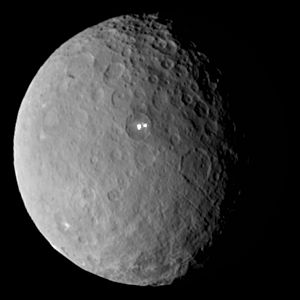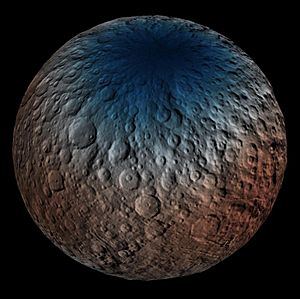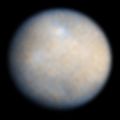Ceres (dwarf planet) facts for kids

Ceres
|
|||||||||
| Discovery | |||||||||
|---|---|---|---|---|---|---|---|---|---|
| Discovered by | Giuseppe Piazzi | ||||||||
| Discovery date | January 1, 1801 | ||||||||
| Designations | |||||||||
| MPC designation | 1 Ceres | ||||||||
| A899 OF; 1943 XB | |||||||||
| dwarf planet main belt |
|||||||||
| Orbital characteristics | |||||||||
| Epoch November 26, 2005 (JD 2453700.5) |
|||||||||
| Aphelion | 447,838,164 km 2.987 AU |
||||||||
| Perihelion | 381,419,582 km 2.544 AU |
||||||||
| 414,703,838 km 2.765 956 424 AU |
|||||||||
| Eccentricity | 0.07976017 | ||||||||
| 1679.819 days 4.599 years |
|||||||||
|
Average orbital speed
|
17.882 km/s | ||||||||
| 108.509° | |||||||||
| Inclination | 10.586712° | ||||||||
| 80.40696° | |||||||||
| 73.15073° | |||||||||
| Physical characteristics | |||||||||
|
Mean radius
|
473 km | ||||||||
| Flattening | 0.067 ± 0.005 | ||||||||
| Mass | 9.46 ± 0.04×1020 kg | ||||||||
|
Mean density
|
2.08 g/cm3 | ||||||||
|
Equatorial surface gravity
|
0.27 m/s² 0.028 g |
||||||||
|
Equatorial escape velocity
|
0.51 km/s | ||||||||
|
Sidereal rotation period
|
0.3781 d 9.074 h |
||||||||
| 0.113 (geometric) | |||||||||
|
|||||||||
| G | |||||||||
| 6.7 to 9.32 | |||||||||
| 3.34 | |||||||||
| 0.84" to 0.33" | |||||||||
Ceres, also known as 1 Ceres, is a dwarf planet in the Solar System. It is located in the middle main asteroid belt between the orbits of Mars and Jupiter.
Ceres was discovered on 1 January 1801, by Giuseppe Piazzi, and is named after the Roman goddess Ceres, as the goddess of growing plants, the harvest, and of motherly love. After about 200 years from its discovery, the International Astronomical Union decided to upgrade Ceres from an asteroid (or minor planet) to dwarf planetary status in 2006.
With a diameter of about 950 km, Ceres is by far the largest and most massive object in the asteroid belt, and has about a third of the belt's total mass. It was once thought to be smaller than Vesta, which is brighter.
Ceres's small size means that even at its brightest, it is too dim to be seen by the naked eye, except under extremely dark skies. As a result, its surface features are barely visible even with the most powerful telescopes, and little was known about it until the robotic NASA spacecraft Dawn approached Ceres for its orbital mission in 2015.
Dawn found Ceres's surface to be a mixture of water ice and hydrated minerals such as carbonates and clay. Gravity data suggest Ceres to be partially differentiated into a muddy (ice-rock) mantle/core and a less dense but stronger crust that is at most thirty percent ice by volume. Although Ceres likely lacks an internal ocean of liquid water, brines still flow through the outer mantle and reach the surface, allowing cryovolcanoes such as Ahuna Mons to form roughly every fifty million years.
Ceres has an unusual crater, Occator which contains bright salts.
Contents
Orbit
Ceres follows an orbit between Mars and Jupiter, near the middle of the asteroid belt, with an orbital period (year) of 4.6 Earth years. Compared to other planets and dwarf planets, Ceres's orbit is moderately tilted relative to that of Earth.
Geology
Ceres is the largest asteroid in the main asteroid belt. Measurements from the Dawn spacecraft found a mean diameter of 939.4 km (583.7 mi) and a mass of 9.38×1020 kg. This gives Ceres a density of 2.16 g/cm3, suggesting that a quarter of its mass is water ice.
Ceres comprises 40% of the estimated (2394±5)×1018 kg mass of the asteroid belt, and it has 3⁄1 times the mass of the next asteroid, Vesta, but it is only 1.3% the mass of the Moon.
Surface
Studies using the Hubble Space Telescope show graphite, sulfur, and sulfur dioxide on Ceres's surface.
Craters
Dawn revealed that Ceres has a heavily cratered surface, though with fewer large craters than expected.
Ceres's north polar region shows far more cratering than the equatorial region.
Atmosphere
In 2017, Dawn confirmed that Ceres has a transient atmosphere of water vapour.
Origin and evolution
Ceres is a surviving protoplanet that formed 4.56 billion years ago; alongside Pallas and Vesta, one of only three remaining in the inner Solar System, with the rest either merging to form terrestrial planets, being shattered in collisions or being ejected by Jupiter.
Habitability
Although Ceres is not as actively discussed as a potential home for microbial extraterrestrial life as Mars, Europa, Enceladus, or Titan are, it has the most water of any body in the inner Solar System after Earth, and the likely brine pockets under its surface could provide habitats for life.
Related pages
| The Solar System | |||||||
|---|---|---|---|---|---|---|---|
|
|
|||||||
| Sun • Heliosphere |
Planets ☾ = moon(s) ∅ = rings |
Mercury | Venus | Earth ☾ | Mars ☾ | ||
| Jupiter ☾ ∅ | Saturn ☾ ∅ | Uranus ☾ ∅ | Neptune ☾ ∅ | ||||
| Dwarf planets | Ceres | Pluto ☾ | Haumea ☾ | Makemake | |||
| Eris ☾ | |||||||
| Small Solar System bodies |
Asteroids (minor planets) |
Groups and families: Vulcanoids · Near-Earth asteroids · Asteroid belt Jupiter Trojans · Centaurs · Neptune Trojans · Asteroid moons · Meteoroids · Pallas · Juno · Vesta · Hygiea · Interamnia · Europa |
|||||
| See also the list of asteroids. | |||||||
| Trans- Neptunians |
Kuiper belt – Plutinos: Orcus · Ixion – Cubewanos: Varuna · Quaoar · Huya |
||||||
| Scattered disc: Sedna | |||||||
| Comets | Periodic comets and non-periodic comets Damocloids · Oort cloud |
||||||
| See also the list of solar system objects | |||||||
Images for kids
-
Giuseppe Piazzi, discoverer of Ceres
-
Orbits of Ceres (red, inclined) along with Jupiter and the inner planets (white and gray). The upper diagram shows Ceres's orbit from top down. The bottom diagram is a side view showing Ceres's orbital inclination to the ecliptic. Lighter shades indicate above the ecliptic; darker indicate below.
-
Artist's conception of Dawn spacecraft
See also
 In Spanish: Ceres (planeta enano) para niños
In Spanish: Ceres (planeta enano) para niños











